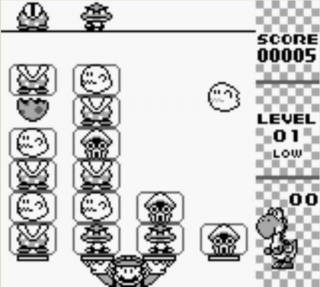Overview
Yoshi (known in Japan as Yoshi no Tamago, or "Yoshi's Egg", and in Europe as Mario & Yoshi) is a falling-block tile-matching puzzle game developed by Game Freak and published by Nintendo for the Nintendo Entertainment System and Game Boy on December 14, 1991 in Japan, on June and July 1992 in North America, and on December 1992 in Europe.
Similar like Nintendo's earlier puzzle game Dr. Mario, Yoshi has players attempting to clear the playfield by matching falling blocks together. However, instead of controlling the falling blocks themselves, players now swap adjacent columns that are stacked on top of trays (held by either Mario or Luigi, depending on the player). The game's namesake comes from special tiles resembling Yoshi Eggs, which can be used to sandwich tiles together to form a Yoshi that grants bonus points.
The NES version was later digitally released as a Virtual Console title for the Wii (in 2007), Nintendo 3DS (first as part of the 3DS Ambassador Program on September 1, 2011, then worldwide on 2012-2013), and Wii U (on June 12, 2013). The NES version was also included in the Nintendo Switch Online - Nintendo Entertainment System service for the Nintendo Switch on September 19, 2018.
It is notable for being Nintendo's first collaboration with Game Freak, who later developed the mainline Pokémon series of role-playing games for Nintendo. They would also collaborate on Mario & Wario, Game Boy Camera, Drill Dozer, HarmoKnight, and Pocket Card Jockey.
Gameplay
 The Game Boy version of the game. While it seems like it's only 4x7, the topmost row is actually on the black line above.
The Game Boy version of the game. While it seems like it's only 4x7, the topmost row is actually on the black line above.In Yoshi, players are given a 4x8 playfield, with each of the four columns held up on a tray. Goombas, Piranha Plants, Boo Buddies, and Bloopers all fall from the sky, each of which can be removed (giving 5 points) by lining two of them up vertically. The game ends once a monster cannot enter the playfield on a full column.
Rather than controlling the falling monsters themselves, players instead guide Mario (or Luigi as the second player in a two-player game) between each tray (using the d-pad) and can press either A or B button to swap the two trays their holding (and the stacks they hold). They can also quicken the fall speed of the falling monsters by holding down on the d-pad. While players cannot normally change the column of falling monsters, they can "push" them to adjacent columns by swapping a column taller than its current position onto it.
Yoshi Egg
In addition to the four standard tiles, the game includes two special tiles: the upper and lower halves of a Yoshi Egg. The lower half acts like a standard monster tile (and can be removed like the others), but the upper half instead performs the following when it lands on a stack:
- If there is a lower half of a Yoshi Egg in the stack, the piece falls down to the topmost lower half, encasing all monsters in-between, and all affected tiles (including both halves). A Yoshi is hatched, which grants bonus points and leaves.
- Otherwise, it is removed by itself for no points.
Players are given bonus points depending on how many enemies are placed between the eggshells, which are shown with the Yoshi that hatches from it:
- Little Yoshi - Zero or one enemies, 50 points.
- Yoshi - Two, three, or four enemies, 100 points.
- Winged Yoshi - Five or six enemies, 200 points.
- Star Yoshi - Seven enemies, 500 points.
Game Modes
There two single-player modes and a multi-player mode. Players can customize both their starting level of difficulty (from 1-5) and two speed options (LOW and HIGH).
- 1 Player, A-Type - The game's "endless" mode, where players start with a clean slate and score as much as they can until they reach a Game Over. Difficulty levels rise by scoring and it makes the tiles drop faster (on top of the chosen speed options).
- 1 Player, B-Type - The game's "round clear" mode, where players clear entire playfields (each starting with full rows of monsters pre-filled) before they reach a Game Over. Difficulty levels rise by clearing rounds and it increases the amount of rows pre-filled at the start.
- 2 Player - Two players compete to win rounds in a best-of-five match. Rounds are won by either clearing their playfield first (with their chosen difficulty level determining how many rows start pre-filled) or having the opposing player receive a Game Over. Both players can choose their starting difficulty and speed, both as a handicap.
Log in to comment